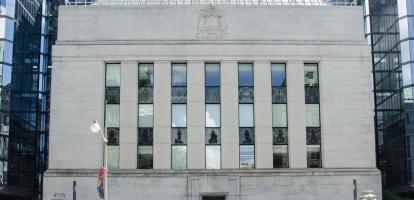Steve Ambler is professor of economics, Université du Québec à Montréal and David Dodge Chair in Monetary Policy at the C.D. Howe Institute, where Jeremy Kronick is director, monetary and financial services research.
Amid conflicting signals, the Bank of Canada decided to press the brakes on the economy a little harder this week, raising the overnight target rate by 25 basis points to 4.75 per cent. And with that, the conditional pause the Bank of Canada announced in January ends. We aren’t so sure it should have.
First, the case for the hike.
The year-over-year increase in the Consumer Price Index (headline inflation), rose in April from March, from 4.3 to 4.4 per cent – the first increase in 10 months, and not consistent with the bank’s projections.
While we have long advocated for looking at more up-to-date indicators of inflation – for example, the annualized three-month inflation rate instead of headline inflation – the three-month rate has indeed risen beyond the bank’s target range.
This three-month measure rose from 2.6 per cent to 3.9 per cent. Annualized three-month core inflation – which strips out more volatile components – also rose, from 3.3 to 3.7 per cent.
Meanwhile, household spending, helped by a historically low unemployment rate, contributed to a surprisingly strong GDP report for the first quarter of 2023. Even purchases of interest rate-sensitive goods, an area that the unprecedented monetary tightening cycle should be slowing, went up. The housing market, which had taken a hit, also seems to be rebounding.
Last inflation expectations data show that in the first quarter of 2023 nearly 80 per cent of people felt inflation would remain above 3 per cent two years from now.
Sounds a pretty convincing case for a hike. But…
Much of the increase in the annualized three-month inflation rate came from a 6.3-per-cent rise in gasoline prices from March to April. Without that, the monthly changes in the Consumer Price Index in those months were the same. Additionally, year-over-year core inflation measures fell.
Monthly GDP figures show that the first-quarter surge happened in January. February and March were flat. The April preliminary estimate showed growth, but with disposable income falling in the first quarter for the first time since the fourth quarter of 2021, we aren’t convinced this growth will last long.
Even the tight labour market is showing signs of loosening. Job vacancies decreased over the last two quarters of 2022, and were at their lowest level since the third quarter of 2021. Pundits have been expecting wage growth to take off, and while in nominal terms they are chugging along at a pace exceeding where they were prepandemic, in real terms they have not yet recovered to where they were before the pandemic hit.
Normally, to be sure, lower real wages would encourage firms to hire more, which would reduce job vacancies. However, we are not seeing that, owing to appallingly low business investment. Gross fixed capital formation, already relatively weak in the first quarter of 2022, has declined in every quarter since then. The Bank of Canada’s own Business Outlook Survey indicator is now at its lowest level since the third quarter of 2020, and the capital stock per worker has been falling since 2015.
So, in a longer-run view, weak business investment does hurt the bank’s fight against inflation, since it reduces the economy’s productive capacity, increasing the inflationary pressure from a given level of spending and activity. Near-term, though, it reduces aggregate demand and the gap between actual and potential activity.
The final, too often overlooked, element in the case against a hike is Canada’s money supply. Just as record money growth in the back half of 2020 and front half of 2021 foretold the inflation that was soon to come, a decline in cash and chequing accounts, and anemic growth in savings accounts are signs inflation will continue to slow.
Monetary policy is a forward-looking exercise and a difficult one at that, with competing shocks happening all the time. In our view, a one-month reversal in the downward path of headline inflation does not make a new trend, and the balance of evidence supported a wait-and-see approach. If the hike was, indeed, overkill, the long-hoped-for decline in the overnight rate will happen sooner rather than later.
Op-Ed from the Globe and Mail





